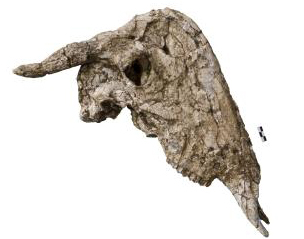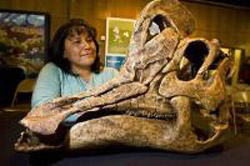The Wildebeest and Lambeosaurine Connection?
Ancient Beast “Honked Like a Hadrosaur”
Convergent evolution throws up strange bedfellows from time to time. Scientists studying an ancient bone bed have uncovered extensive fossil material from an ancient wildebeest that shows that this hoofed mammal had a raised nasal dome, reminiscent of a hollow crested duck-billed dinosaur. Researchers have suggested that the bizarre anatomical structures helped these herd animals communicate more effectively. It’s a question of what evolution did for the likes of Corythosaurus some 75 million years ago has been repeated in a Pleistocene bovine from around 75,000 years ago.
A Trumpeting Wildebeest – Rusingoryx atopocranion
Picture credit: Todd Marshall
The ancient ungulate (hoofed mammal), was poorly known until a bone bed containing the remains of at least twenty-four individuals was discovered on Kenya’s Rusinga Island. The fossilised remains, which includes juveniles as well as adult animals, has enabled scientists to piece together a much more comprehensive picture of the anatomy of this grazing mammal, part of a diverse African bovine fauna that flourished on the hot, dry savannah of southern Africa during the Pleistocene Epoch.
Stone tool marks on the bones indicate that these animals were butchered and it has been suggested that Middle Stone Age people had driven the animals into a river and ambushed them, or perhaps, a tribe benefited from a chance discovery of a group of these creatures who had recently drowned in a flood event.
Hollowed-out Headgear
The wildebeest is known as Rusingoryx atopocranion, but until now it had only been known from partial remains, including incomplete skulls. The Rusinga excavation, supported by the National Geographic Society’s Committee for Research and Exploration has uncovered a total of six skulls, most of them complete. Thanks to these fossils, scientists have a much better idea of what these animals actually looked like.
Commenting on the new evidence, lead author of the study, Haley O’Brien (Ohio University) stated:
“The first time I saw them my jaw completely dropped”.
Previous studies based on much less complete fossil material had speculated that Rusingoryx possessed a proboscis, but the new skulls discount this idea. Instead, they reveal that R. atopocranion had a high nasal dome in front of its eyes, a sort of “cow with a Roman nose”. The raised naris was hollow, encasing a winding, circuitous nasal passage.
The Skull of Rusingoryx (R. atopocranion)
Picture credit: Haley O’Brien
Strange Nasal Apparatus
PhD student Haley explained:
“There aren’t any living animals with a nasal apparatus like this, but there are some fossil ones. Outside and in, the nose of Rusingoryx resembles the hollow crests of the “duck-billed” dinosaurs, animals like Corythosaurus and Lambeosaurus, which lived about 75 million years earlier. Both groups essentially push the nasal part of their airway into the crest and they’re using similar suites of bones to form the crest itself.”
The Skull of the Mexican Lambeosaurine Velafrons (Velafrons coahuilensis)
Picture credit: Paul Fraughton/Salt Lake Tribune
Commenting on the similarities between Rusingoryx and Late Cretaceous duck-billed dinosaurs, palaeontologist David Evans (Royal Ontario Museum, Toronto), stated that he was “blown away” by the skulls of Rusingoryx, he added:
“The resemblance between Rusingoryx and some hollow-crested dinosaurs in the form of the nasal structures is truly striking.”
Convergent Evolution
The dome shaped nasal area of Rusingoryx is an example of convergent evolution, whereby unrelated organisms evolve independently similar features, such as the streamlined bodies and tail flukes of dolphins and ichthyosaurs. These are adaptations to similar habitats or ecological niches.
However, faced (no pun intended), with this strange-faced wildebeest, the big question is what sort of function did these domed noses have?
A number of ideas have been put forward:
- The expanded naris played a role in cooling or warming incoming air
The large nose of Rusingoryx may certainly have been able to undertake this function and all mammals have some ability to do this, thanks to scroll-like bones called turbinates that increase the surface area of the nose. As Rusingoryx lived in a very hot, dry environment this theory is plausible, but the dome’s internal anatomy did not support this conclusion.
- The raised domes were used in ritual combat
A number of bovines use their skulls as battering rams to settle disputes and as defensive weapons. However, the skull bones of Rusingoryx are very thin, much thinner than those of extant Artiodactyls (even-toed hoofed mammals) that indulge in such behaviour.
- The nasal area acted as a resonating chamber for sound
A Resonating Chamber?
Social, hoofed, herd-dwelling herbivores tend to be quite vocal. They have ways to modulate their vocal tracts to increase the variety and range of sounds that they can make. The skull anatomy suggests that the big dome-faced wildebeest used this structure to vocalise.
Student O’Brien explained:
“We calculated a frequency of between 250 and 750 hertz, which is not only pretty low, it also overlaps with the sonic frequencies of a vuvuzela. Rusingoryx could very likely make a low trumpeting sound but there’s a good chance it could also vocalise in stealth mode.”
Being able to communicate at a low frequency making it difficult for some predators to hear, has a distinct evolutionary advantage, human hunters for example would have had difficulty picking up these sounds. In addition, a herd of these animals would have been capable of making a lot of noise, much like a stadium full of South African football fans waving their vuvuzelas.
Everything Dinosaur stocks a range of duck-billed dinosaur models and replicas including many lambeosaurines. To view the model’s section of the company’s award-winning website: Dinosaur and Prehistoric Animal Replicas.




